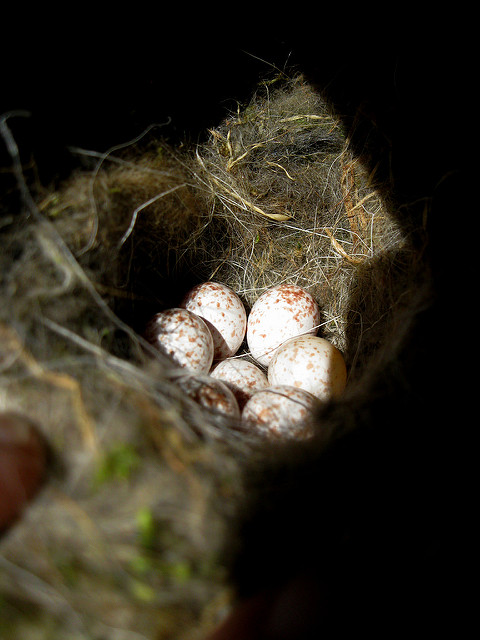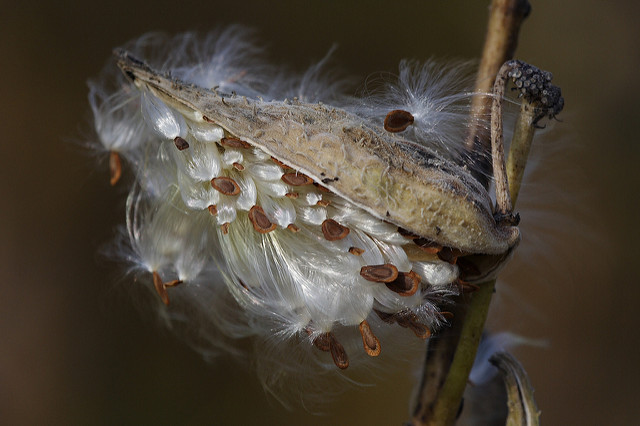Change is inevitable. Night becomes day. Winter gives way to spring. Caterpillars turn into butterflies, eggs into baby birds, acorns into mighty oaks, seedpods into clouds of fluff.

Chickadee Eggs by Jennifer Schlick
I close my eyes in the dark and wake up with the sun streaming in my window. The change seems instantaneous. If we are lucky, though, and attentive we can enjoy the entire transition. And often, we will find that the really interesting stuff takes place in the in-between. As night becomes day, the sky gradually brightens as the stars slowly fade. The sun paints the sky and clouds with colors that will last but a few minutes. The silence of the night is replaced with bird songs that are strongest in the morning, then fade as the day goes on. Dawn has more than her fair share of dramatic events compared to the rest of the day.
Spring is the transition from winter to summer. Temperatures vary. Snow melts and returns and melts again. Creeks fill with snow melt, freeze, and repeat. The woodland spring flowers emerge and live out their short lives in waves. Trees flower and set fruit. Buds become leaves. Forest creatures begin their busy time, each species on a different schedule. Shadows shorten. Daylight time lengthens. Compared to the long stretches of cold and snow that is winter and the long stretches of sunshine and heat that is summer, spring is… well, transitional! If you walk mindfully through the woods in springtime you will note rapid change and dramatic transformation.
I have been reflecting quite a bit on transitions in nature and relating them to some of the changes we are going through at Audubon Community Nature Center. Perhaps you’ve read that we hired another naturalist, or that our president is retiring. Perhaps you’ve been asked to participate in a survey to help us determine some of next steps. Change is imminent and we are in that messy, sometimes chaotic time between the old and the new. In his book Managing Transitions, William Bridges calls it “the neutral zone.”
Bridges acknowledges the uncertainty and anxiety of the neutral zone, but also points out that it can be a time of great creativity, a place to try different ideas. We find ourselves at ACNC asking lots of questions. Are there things we should be doing that we aren’t? Are there things we are doing that we shouldn’t? How could we do this more efficiently? What do people want from us? How can we best serve them? How can we all get on the same page about… (fill in the blank)? And tons of questions that start with the words “what if.”
It is exciting and energizing. It is frustrating and exhausting. We are doing what we can to make changes that are good for us and good for you and we are working hard to manage our transitions smoothly. We trust that just as dawn, the transition between night and day, offers some of the most dramatic and beautiful skies, and just as spring presents some of the most interesting of nature’s phenomena, we will come through this “neutral zone” an even more vibrant and relevant organization.

Milkweed Seedpod by Jennifer Schlick
Do you want to be a part of it? There are many ways to become involved. Volunteer. Become a member. Attend a program. Simply come and chat with us. We’d love to have you as part of the ACNC family.
Simply come and chat with us. We’d love to have you as part of the ACNC family.
Audubon Community Nature Center builds and nurtures connections between people and nature. ACNC is located just east of Route 62 between Warren and Jamestown. The trails are open from dawn to dusk as is Liberty, the Bald Eagle. The Nature Center is open from 10 a.m. until 4:30 p.m. daily except Sunday when it opens at 1 p.m. More information is online at auduboncnc.org or by calling (716) 569-2345.
Jennifer Schlick is program director at ACNC.


Recent Comments